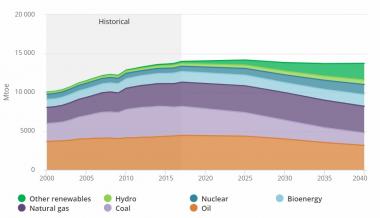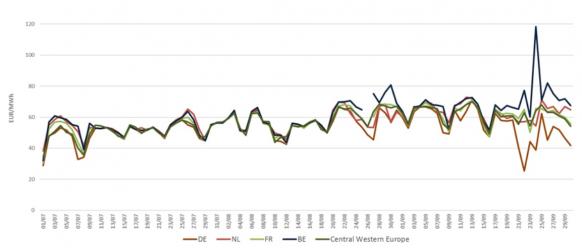Shell aims to be world’s largest power company; Orsted bundles hydrogen sales into offshore bid
Our pick of the latest wind power news you need to know.

Related Articles
Shell aims to become world's largest electricity company
Oil and gas major Royal Dutch Shell will become the world's largest electricity company by the 2030s if it achieves its goals for cutting greenhouse emissions, Maarten Wetselaar, Shell’s director of gas and new energies, said at a conference in Houston.
As the world moves towards an electrification of energy supplies, Shell could expand its power business to the same size as its oil and gas operations, Wetselaar told the Financial Times.
This expansion would include power trading and the supply of power and equipment and would require returns on capital of 8 to 12% over the period, Wetselaar said.
Global primary energy demand
Sustainable development scenario
(Click image to enlarge)
Chart note: The above sustainable development scenario (SDS) assumes an integrated approach to achieve internationally-agreed objectives on climate change, air quality and access to modern energy supplies.
Source: International Energy Agency (IEA).
Shell sees major opportunities in the decentralized power market, where it believes it has an advantage over established power utilities that own conventional coal and nuclear power plants. Shell believes it is well-placed to deploy advanced technologies and trading services in decentralized networks.
Shell recently entered the U.S. offshore wind market and is developing floating wind technologies. Other recent investments include the acquisition of German energy storage group Sonnen and UK power supplier First Utility.
By 2020, Shell plans to invest $1 to $2 billion a year in new energy technologies including electricity.
“We will do that for a number of years,” Wetselaar said.
“And then we will scale it up, because otherwise we will never get there,” he said.
Orsted includes “green hydrogen” in Dutch offshore wind bid
Denmark's Orsted is developing green hydrogen projects as part of its bid for the Holland Coast South 3&4 projects in the Netherlands, the company announced March 14.
Orsted is the world's largest offshore wind developer by capacity and plans to increase its installed capacity from 5.6 GW to 15 GW by 2025.
Recent offshore wind tenders have produced zero-subsidy bids, exposing winning developers to wholesale market risks.
Orsted proposes to use power from the Holland Coast South 3&4 wind farms to produce hydrogen, which would be sold to industrial customers to provide additional revenue to the operator.
Central, Western European (CWE) power prices
(Click image to enlarge)
Source: European Commission Quarterly Electricity Market Report. Data source: EPEX, S&P Global Platts.
"We believe that our bid for Holland Coast South 3&4 offers significant benefits for the Dutch society in terms of clean and cost-competitive energy as well as industrial development," Henrik Poulsen, CEO and President of Orsted, said.
"We are ready to scale-up and bring down costs of green hydrogen like we have done with offshore wind," he said.
Orsted is currently building the nearby 752 MW Borssele 1&2 wind farm. Due for completion by Q1 2021, Borssele 1&2 will be Netherlands' largest offshore wind farm to date.
This year, Orsted will build an operations & maintenance (O&M) base for Borssele 1&2 in Vlissingen, Zeeland. The base will create 50-100 permanent and highly skilled jobs in Zeeland for the operational lifetime of the facility.
Orsted sees the U.S. offshore wind market as a key growth area and the company has recently strengthened its presence through a series of recent acquisitions and partnerships.
US group develops new 2.1 GW power line from Iowa to Illinois
Infrastructure developer Direct Connect Development Company (DC DevCo) is developing a 2.1 GW high-voltage underground transmission line to transport wind and solar power 349 miles from the midwest MISO market to the north-east PJM markets.
The “SOO Green Renewable Rail” transmission line would run from Mason City, Iowa, to Chicago, Illinois and could be online by 2024, DC DevCo said March 11.
Copenhagen Infrastructure Partners (CIP), Siemens Financial Services and engineering and construction group Jingoli Power, have agreed to invest in the project. Siemens would supply and install the associated HVDC converter stations.
DC DevCo believes that burying the line underground would avoid permitting and access issues encountered by overground long-distance transmission projects.
The majority of the line would be buried along an existing railroad, following a model used for fibre-optic cables.
Last August, American Electric Power (AEP) cancelled a project to build a 2 GW windfarm and 350-mile transmission line in the U.S. Interior after the Public Utility Commission of Texas (PUC) denied approval.
The "Wind Catcher" project involved the development of the U.S.'s largest wind farm in the Oklahoma Panhandle and construction of a transmission line to send the power to eastern Oklahoma. The project also proposed to serve customers in Texas, Louisiana and Arkansas.
The PUC said the project did not provide enough benefits for ratepayers. Oklahoma authorities had already questioned the benefit to consumers and were yet to make a final decision. The project had gained approval from federal, Louisiana and Arkansas authorities.
“To realize the full benefits of Wind Catcher for customers, timely approvals were required from all jurisdictions so we could complete the project by the end of 2020 and be eligible for 100% federal production tax credit," Nicholas Akins, AEP chairman, president and chief executive officer, said in a statement.
New Energy Update


